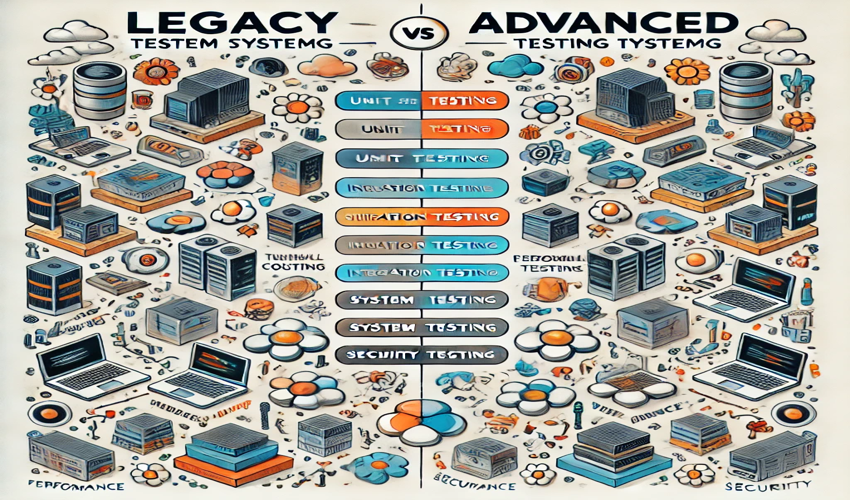When it comes to software development, testing is an essential aspect to check that the systems deliver what is expected of them. However, when it comes to the analysis of Legacy Vs Advanced System Testing Levels, there is a vast difference between these two levels and the manner in which the systems are tested due to the structural, technological, and availability of testing tools.
Unit Testing
Legacy Systems:
Some of them are having programming languages which are no longer supported or outdated, there are no unit testing frameworks available for most of them, and the components are tightly coupled which does not allow us to apply test cases at unit level.
Advanced Systems:
Most of the today’s high-level programming languages and frameworks support comprehensive unit testing features that make it easy to automate testing and perform modular testing. Other development methodologies such as Test Driven Development (TDD) do improve the efficiency of unit testing.
Integration Testing
Legacy Systems:
By introducing complex relationships between the out-of-the-box modify and other systems, IT becomes complicated and challenging to solve problems resulting in data misinterpretation and a lack of capability to create integration environments. These systems are frequently informal and it can be difficult to clearly delineate what integration points are.
Advanced Systems:
Current architectures – especially the recent microservices- or modular-style of architectures – are designed to be more easily tested in an integrated way. Software like Docker for integration assistance are important in ensuring that integration gets done seamlessly among systems for the integrated software systems.
System Testing
Legacy Systems:
Legacy environments cause difficulties in system testing because: There could be no or little documentation available for reuse Application designed for testing may not have defined behaviors – it could do something different to what is expected Hardware and software technology might get outdated and restrict testing effectiveness. Test environment maybe different from the production environment, therefore coming up with inconsistent test results.
Advanced Systems:
Advanced systems have much more documentation for the developers, virtual environments for testing and high mimetic practice of usage scenarios. Continuous integration/continuous deployment (CI/CD) pipelines are typically used to back system testing.
User Acceptance Testing (UAT)
Legacy Systems:
This is especially so because users who are required to conduct UAT for legacy systems may not have worked with the interface and workflows before. Overhead and time delays in feedback and interrogation mechanisms as well as slow learning in most legacy platforms are the causes of bottlenecks.
Advanced Systems:
Rapid application development presents more friendly interfaces and communication with feedback of a user in modern systems. Modern approaches and tools, such a Jira or other Scrum solutions, help to make UAT more effective and friendly to change requests.
Performance Testing
Legacy Systems:
Legacy systems are most often burdened with old machines and software, thus not very scalable and are quite hard to do proper load and stress testing. Of course, other performance problems might be well concealed and difficult to detect during their solving.
Advanced Systems:
Sophisticated systems build upon cloud services for load stability allowing for easy imitation of various loads to find out the weak spots. For testing large-scale performance across distributed systems there are many tools available today like JMeter or Gatling.
Security Testing
Legacy Systems:
Testing of security is normally done rather late and in low integrity systems this is due to inherent poor technologies and protocols of the system. Forgetting and correcting legacy systems, compatibility and unsupported software can be a real problem.
Advanced Systems:
Security has become an enabler throughout the application development life cycle in today’s systems accompanied with tools such as DAST and SAST to border-grade risks insight.
Regression Testing
Legacy Systems:
Regression testing is exhaustive and time-consuming in legacy systems thanks to a lack or automation and the non-modular nature of many testing processes.
Advanced Systems:
The problem of regression testing is also automated in modern systems, as part of CI/CD processes to allow for faster feedback, and luck more consistent identification of mistakes when new code is integrated.
Difference between Legacy Vs Advanced System Testing Levels
| Testing Level | Legacy Systems | Advanced Systems |
|---|---|---|
| Unit Testing | Outdated languages, limited frameworks, tight coupling | Modern frameworks, modular testing, automated tools |
| Integration Testing | Complex interdependencies, lack of documentation | Easier integration, containerized environments |
| System Testing | Limited testing environments, inconsistent results | Realistic environments, CI/CD support |
| User Acceptance Testing (UAT) | User unfamiliarity, slow feedback mechanisms | User-friendly interfaces, interactive feedback loops |
| Performance Testing | Legacy hardware limitations, difficult to scale | Scalable cloud infrastructure, modern tools |
| Security Testing | Vulnerable due to outdated protocols, harder to secure | Integrated security testing, proactive vulnerability detection |
| Regression Testing | Manual, resource-intensive, slow process | Automated through CI/CD, faster and consistent |
SumUp
Legacy Systems: Following difficulties are faced due to it: Architecture is not compatible up to date, There are no testing frameworks, and Tight coupling. Testing is almost always manual, time-consuming and full of discrepancies.
Advanced Systems: Take advantage of features that enable modularity, instrumentation tools, and methods. These tools enhance the efficiency of testing, speed, and size as well as scalability across different stages of testing.
This comparison shows how the modern testing practices have been improved to deal with the testing level challenges that the legacy systems face. The advancement in the complicated systems is better hence faster and more efficient in the established new systems.
Conclusion
Finally, as far as Legacy Vs Advanced System Testing Levels it can be concluded that advanced system indeed have certain edge because they have more modern tools, frameworks and methodologies available at their disposal. It is crucial for many organisations to continue working with legacy systems, but they entrain specific approaches to address inherent difficulties, on the other hand, the new ones and improved systems benefit from automation, modularity and integration of testing, which make the process easier and more efficient.

Software Testing Lead providing quality content related to software testing, security testing, agile testing, quality assurance, and beta testing. You can publish your good content on STL.



